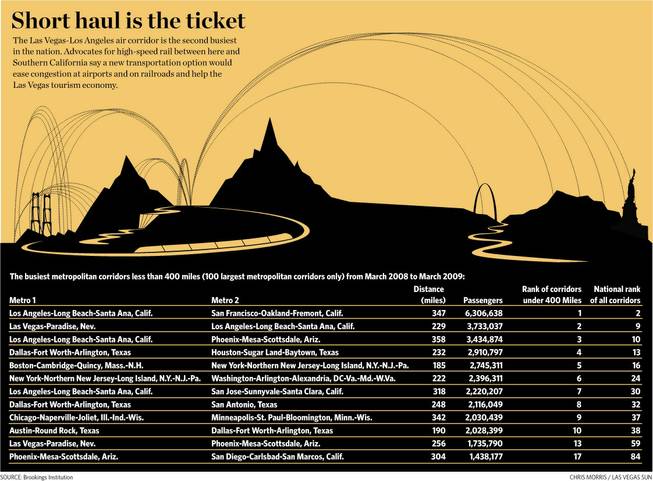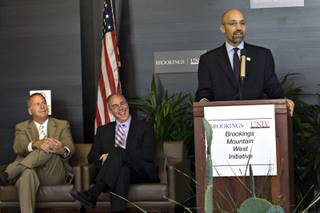Thursday, Oct. 8, 2009 | 2 a.m.
Las Vegas offers more direct connections than most
Rank - Metro area - Connections
- 1. Atlanta - 145
- 2. Chicago - 133
- 3. Denver - 127
- 4. Dallas-Fort Worth - 124
- 5. Minneapolis-St. Paul - 122
- 6. Detroit - 114
- 7. Houston - 109
- 8. Charlotte - 98
- 9. Las Vegas - 97
- 10 New York-Northern New Jersey - 96
- 14. Salt Lake City - 84
- 15. Phoenix - 83
- 35. Albuquerque - 35
- 49. Tucson - 22
- 57. Boise City - 18
- 64. Colorado Springs - 15
- Source: Brookings Institution
On-time
Intermountain West airports deliver some of the best on-time performances in the nation. Experts attribute this to clear skies and plenty of open space around airports.
% arriving on time - % departing on time - average delay (in minutes)
- Salt Lake City - 86%-88.6%-50.3
- Phoenix - 83.1% -83.7%-48.6
- Albuquerque - 83%-86.1%-49.1
- Boise City - 82.6%-87.3%-51
- Tucson - 82.1%-88.6%-49.1
- Las Vegas - 81.4-81.4-51.1
- Denver - 80.4%-80.9%-53.9
- Colorado Springs - 79.9%-86.6%-53.9
- Intermountain West - 82.3%-85.4%-50.7
- Top 100 metros - 78.8%-84.5%-56.7
- National 76.1%-81.1%-56.8
- Source: Brookings Institution
Sun Archives
- Six Questions for Robert Lang (9-10-2009)
- The potential for prosperity in Las Vegas (9-9-2009)
- Experts: Despite downturn, Las Vegas has hope (9-8-2009)
- Washington think tank with ideas for the West starts UNLV partnership (9-8-2009)
- UNLV forms partnership with Brookings Institution (9-2-2009)
Brookings Institution Annoucement
The Brookings Institution and UNLV announced its new Mountain West Initiative Tuesday morning at UNLV's Greenspun Hall.
A new analysis of air travel in the Intermountain West suggests Las Vegas would be an ideal hub for a high-speed rail network and — because of the heavy load of travelers between McCarran International Airport and Southern California — is primed for a high-speed rail link connecting the two regions.
The report, prepared by the centrist Brookings Institution, points out that McCarran is one of the busiest short-haul airports in the country, shuttling millions of travelers to and from Los Angeles, Phoenix, Denver, Salt Lake City and other Western cities. About 3.7 million passengers shuttled between Las Vegas and Los Angeles in the year ending March 2009.
The data would seem to provide fresh evidence for advocates of high-speed rail. Transportation experts say high-speed rail makes the most sense for two large, tightly linked metropolitan areas 200 to 500 miles apart.
“Your region has come late to the high-speed rail scrimmage, but this evidence suggests that there’s a legitimate claim to be made,” said Mark Muro, a co-author of the report and a senior fellow at Brookings, which recently formed a partnership with UNLV.
The high-speed rail debate has kicked up since the election of President Barack Obama, whose administration budgeted $8 billion in seed money for a series of rail links across the country, including one from here to Southern California, which provides as much as one-third of Vegas tourist traffic on a given weekend.
The Las Vegas-L.A. rail idea has been mocked by some Republicans, who called it the “Disney Train” or the “Gambling Train,” though the volume of air and car traffic from here to Southern California would seem to suggest that if high-speed rail should be built anywhere, it’s here, Muro said.
“Our point here is that the criteria in corridor decisions are unfolding in a highly political, quite rhetorical, facts-come-last environment, and that the evidence ought to be considered,” Muro added.
Stephen Van Beek, president of the Eno Transportation Foundation, a transportation think tank, agreed: “Vegas is the right type of market for high-speed rail.”
For now, however, a rail link to Southern California, which has been discussed for decades, faces significant obstacles.
There are two competing visions for high-speed rail here. This summer Senate Majority Leader Harry Reid announced his support for DesertXpress, the proposed 150-mph, privately operated train — to be financed in part with government loans — that would travel to Victorville, the high-desert community 80 miles from Los Angeles.
Supporters of a competing magnetic levitation train haven’t surrendered their hopes for the $12 billion, publicly financed 300-mph line that would carry passengers between Las Vegas and Orange County.
The Brookings report raises other important issues for national and regional transportation officials, chiefly on the issue of air traffic congestion.
Policymakers have some breathing room to confront the issue of congestion because the recession has decreased air traffic. Especially hit is McCarran, where the passenger count has dropped from a peak of nearly 48 million passengers in 2007 to an expected 40 million this year.
An expansion will bring McCarran’s capacity to 53 million passengers in 2012.
But transportation officials say congestion — and long delays that result — will return. The Brookings report suggests “congestion pricing” — higher taxes for flights during peak times and lower taxes for off-peak; more money for the busiest airports, which currently receive a lower proportional share because Congress must distribute money to small airports to get needed political support; as well as quicker implementation of new air traffic control technologies.
Randall Walker, director of Clark County’s Aviation Department, noted that with a national, interconnected aviation system, there are no easy solutions.
He said the airport has never viewed itself as a servant of the airlines, and said he supports the idea of high-speed rail as a transportation option between here and Southern California.
The idea isn’t universally supported, however.
Gabriel Roth, a research fellow at the Independent Institute, said the billions proposed for high-speed rail would amount to a massive taxpayer subsidy for the train’s middle- and upper-income passengers, whereas road and air passengers pay their own way with user taxes, such as the gas tax.
“I’m skeptical of anything for which customers are not prepared to pay. That’s my critique,” he said.
Mass transit advocates reply that drivers and airline passengers receive all kinds of subsidies of their own.
Roth advocates a dedicated, high-speed bus lane as more efficient and cost effective.
Rail advocates point to advantages of a high-speed rail link other than just less congestion. Pete Dronkers of Environment Nevada notes that high-speed rail would create one-fourth the pollution of comparable air travel and one-third that of auto traffic.
Van Beek said that after decades of failing to develop a comprehensive transportation plan that coordinates all modes, now is the time: “What policymakers need to do at a national level and the regional level is look at all alternatives and determine costs and benefits.”



Join the Discussion:
Check this out for a full explanation of our conversion to the LiveFyre commenting system and instructions on how to sign up for an account.
Full comments policy